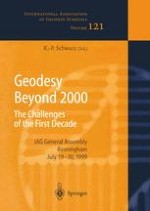2000 | OriginalPaper | Buchkapitel
On the modeling of long wavelength systematic errors in surface gravimetric data
verfasst von : Nikolaos K. Pavlis
Erschienen in: Geodesy Beyond 2000
Verlag: Springer Berlin Heidelberg
Enthalten in: Professional Book Archive
Aktivieren Sie unsere intelligente Suche, um passende Fachinhalte oder Patente zu finden.
Wählen Sie Textabschnitte aus um mit Künstlicher Intelligenz passenden Patente zu finden. powered by
Markieren Sie Textabschnitte, um KI-gestützt weitere passende Inhalte zu finden. powered by
A satellite-only model and a set of 1°x1° area-mean terrestrial gravity anomalies were used to estimate simultaneously geopotential coefficients to degree and order 70 and a set of spherical harmonic coefficients representing regional systematic errors in the gravity data. Several test solutions were developed whereby the weighting of the gravity data and the maximum degree and order of the systematic bias coefficient set were varied. The results were evaluated using both internal consistency statistics (e.g., a posteriors signal and error statistics, calibration factors) and comparisons with independent data (orbit fits, comparisons with GPS/leveling-derived geoid undulations). The global RMS error correlation between geopotential and bias coefficients was 6.7% for an unconstrained bias expansion to degree 20, and 7.8% for an expansion to degree 25, where an a priori constraint on the bias parameters was also employed. The bias expansion to degree 25 resulted in a slight degradation of the results from comparisons with GPS1leveling-derived geoid undulations or height anomalies. Optimization of this technique requires additional tests, especially with regard to terrestrial data weighting issues. Future satellite missions (e.g., CHAMP, GRACE and GOCE) will permit bias recovery at finer resolution, thereby improving the ovesrall effectiveness of this technique.
